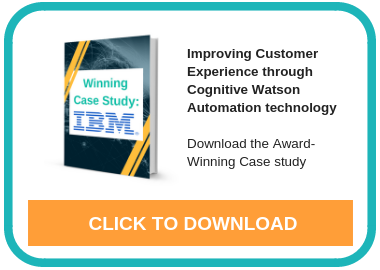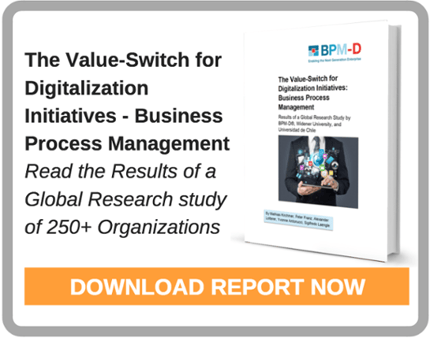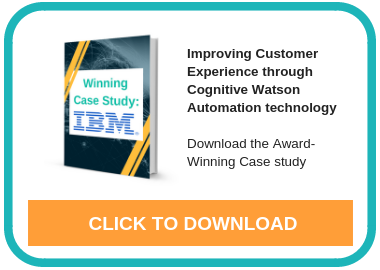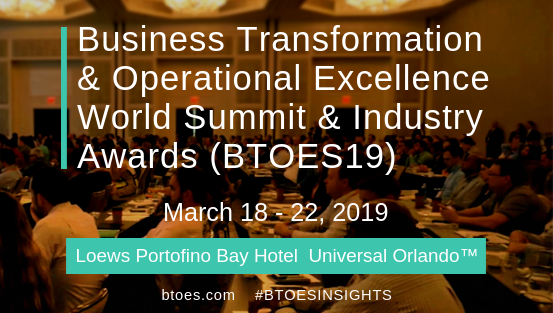What is Robotic Process Automation?
A Definition of Robotic Process Automation
Robotic Process Automation is an enabler of the transformation of business processes to become more efficient, agile, meet compliance requirements, enhance customer experience or improve the general quality of deliverables. It brings the ability to drive the automation of existing or emerging technology in a number of industry sectors. There is attended RPA with human intervention and unattended without human intervention RPA.
Robotic Process Automation is transforming how companies maximise their efficiency across all industries. Using AI robots and software, businesses are able to replicate the behaviours of a human worker with a near 0% defect rate. However, for companies practising Operational Excellence, there is a fine line to walk between streamlining to maximise efficiency, and quality of the product/service - for example, in the case of areas such as Customer Experience. Learn more about Robotic Process Automation in Operational Excellence.
Watch this Video from Deloitte on 'What can robotics do'.
Robotic Process Automation Tools
RPA tools
RPA tools are software programs that operate on the user interface of other computer systems in the way a human would do . They basically recognize and read fields on a screen of an application software, modify the content if necessary and enter it into other fields of the same or different software. All of that happens based on predefined rules . The integration of artificial intelligence (AI) and Cognitive Automation components into the RPA tools makes them even more powerful since RPA starts handling unplanned situations and deal with unstructured data. Also, the handling of verbal information is possible using “Chatbots” in an RPA environment.
The use of RPA basically transfers the application of robots from the industrial manufacturing environment to the office and service area. Just like industry robots automate routine manufacturing and assembly steps RPA robots automate the human work with data and information. Read more.
Robotic Process Automation is mainly used to automate processes which are:
- Repetitive
- Prone to error
- Rules based
- Involving digital data
- Time critical and seasonal
Buying an RPA licence could be cheaper than a salary of an employee which is a plus for this technology. Furthermore the Automation System will most likely beat the human in accuracy, timeliness, and operational flexibility. Read more.
Benefits of Process Automation
Why Robotic Process Automation?
Everybody is talking about the benefits of Robotic Process Automation (RPA) but what are they? With Assistance of RPA some tasks don't have to be done by humans, which leaves them with more time to do other tasks, like being creative and enhancing the business in other ways, the RPA can't. For example customer satisfaction. The employees will also be able to add more value as they have more time. Both RPA and employees should work together.
Other benefits are:
- Decreased cycle times and improved throughput
- Flexibility and scalability
- Improved accuracy
- Detailed data capture
A Survey conducted by Deloitte in September 2017 shows that "awareness of robotics remains high. Even more organisations have investigated the RPA opportunity and/or built a proof of concept. They are convinced robotics will deliver a significant productivity increase and that it is applicable for a significant portion of their activities."
"RPA can also add value in the technical field of software integration. The tools can read the data produced by one application and enter it into another one, achieving an integration effect without developing costly interfaces or changing existing software. This leads to efficiency effects in the information technology department and provides business users the required integration to enhance process performance.
In the meantime, RPA solutions are offered by a continuously growing number of vendors. The Gartner Group, for example, mentions 15 vendors in their RPA market guide. RPA software is offered often at an aggressive pricing or even for free. Also implementation cost start at a relatively low level. All this makes RPA look like a pragmatic and powerful solution. As a consequence more and more public and private organizations use or plan to use RPA." Read the whole Article by Dr. Mathias Kirchmer.
A Critical View on RPA
Risks of RPA
"While all this sounds promising, the use of RPA creates also some risks, like basically every automation technology does. While RPA helps to do routine work faster and at a higher quality it also can make mistakes faster and with certainty. There is no human check before executing an action. Poor data quality or the insufficient definition of business rules can lead, for example, to the ordering of the wrong parts – fast and in big quantities. Or missed claim types can lead to significant rework in the claims handling, overcompensating the automation benefits. RPA requires detailed knowledge about the business process it is used in – otherwise expected performance improvements will not be realized.
The use of RPA may also just cover symptoms without correcting the real reasons for issues. RPA may, for example be used for the automated reconciliation of account differences. However, in the mid and long-term, it would be much more beneficial to correct the issues leading to those differences. Hence, RPA may hinder real progress.
RPA vendors stress that their tools are easy to implement and use – also for a business person. This may be right for simple straight forward applications. However, to achieve full potential of sophisticated RPA environments some expert know how is required for implementation and ongoing adjustment. This should be part of the process management capabilities of the organization, or RPA expectations may not be met or not met fully.
These potential risks can make RPA a dangerous illusion. However, those risks can be minimized by addressing RPA the right way." Read more.
Watch this exclusive video on 'Demystifying Jidoka: Transforming machines to become Autonomous, to operate without human intervention':
Robotic Process Automation vs. Jobs
Can RPA become a threat to our jobs?
Many people fear that Robots will become a threat for workplaces and will soon replace us and employees will become dispensable. Dr. Mathias Kirchmer is convinced this won't happen. Click here to know more!
Dana McInnis believes that RPA might be replacing some of our tasks, but only to our advantage:
"One of the best lines in any movie ever (which just happens to be from “Office Space”) is, “We don’t have a lot of time on this earth. We weren’t meant to spend it this way. Human beings were not meant to sit in little cubicles staring at computer screens all day, filling out useless forms and listening to eight different bosses drone on about mission statements.” It’s true: human beings are capable of so much more than manually managing mundane tasks. [...]
First, the idea that employees are primarily valuable because they execute manual processes is a skewed perception. Employees are not valued because they can run a manual process. They are valued because of a commitment to excellence, their desire to help their teams and because they care about the company for which they work. [...]
The employee performing manual tasks could be doing other things in the company to make things better enterprise-wide. Rather than execute the same manual process every day, they could be resolving the exceptions/errors that may occur in the automated process. They could learn a new skill and become the workplace “hero” in a different way, such as the administrator of a system that provides the automation. [...]
The right combination of process and technology can be a game changer to a company’s bottom line, and one’s career."
Business Process Management vs. Robotic Process Automation
How does RPA influence BPM?
We’ve been discussing the imperative value of collaborative BPM for years and it’s certainly no longer a new concept. Yet many BPM initiatives that start off with the best intentions begin to stagnate when the project becomes the exclusive domain of highly-trained process experts working in isolation. For BPM to reflect the digital world, process initiatives need to expand their focus away from process design. Adoption of process thinking across departments and throughout your team is more important than process design perfection. Therefore, tapping into the wealth of knowledge and experience already available to you within your workforce is the real key to achieving success. The best way to win people over to a new, targeted and compliant approach is to involve them in creating the solution. Process stakeholders are the most capable of recognizing bottlenecks and issues in the processes they carry out on a daily basis – they are also unlikely to resist changes and improvements that they have suggested themselves.
Despite the obvious importance of process modeling and simulation, aspects such as automation and workflow should also be intrinsic to fit-for-purpose business software applications in the digital world. BPM practice needs to go beyond modeling and also embrace the operationalization of business processes in modern digital workplaces, by automating tasks and carrying out operational processes in a target-driven and measurable way. Read more.
Back to top
Innovation
What is Innovation really ?
Researching what Innovation means seems to be harder than expected. But then we found this very interesting Blog by Idea to Value about Innovation which doesn't give THE definition but has a whole different approach to giving a definition: asking experts and thought leaders of the industry.
"Innovation is truly a confusing buzzword which many people love to hate.
Every business leader agrees that it is important. But nobody can quite seem to agree on what it actually is or what it means.
If you ask Google for an innovation definition, it is less than helpful, coming up with over 300 million results with thousands of definitions. Its own definition is pretty much useless: “the action or process of innovating”. Using the traditional sources for a definition such as the Oxford dictionary also doesn’t help much, with their answer being “Make changes in something established, especially by introducing new methods, ideas, or products”
So I contacted a selection of my fellow innovation experts to see how they talk about innovation with their clients, and compiled the results for you here. I asked them all:
Artificial Intelligence
What is Artificial Intelligence?
Did what we have seen in many films over the past years become the reality? Have machines evolved?
Artificial Intelligence (AI) are machines which are able to solve problem, as well as learning new information and behavior by interacting with humans and the environment.There are many ways we are in contact with Artificial Intelligence on a daily basis Siri on our IPhone and Alexa by Amazon are only two examples on how much it has already changed our lives. But very importantly A.I. has reached businesses where it can complement our human skills, help improve processes and make us more effective. Click here to see more examples of Artificial Intelligence in our Everyday life.
'SILICON-BASED LIFE FORMS & CUSTOMER SERVICE: MY INTERVIEW WITH A ROBOT', by Ian Gotts, CEO and founder of Q9 Elements, introducing his interview with a robot:
"Recently my iMod – an iPod with internal electronics replaced with Hi-Fi components – stopped working. (Yes I am a Hi-Fi nerd but the sound quality is fantastic). As it was expensive and had been modified in the US I wasn’t too comfortable giving it to just anybody to fix. So I asked around and the iPod Surgery was recommended.
I went to their site which seemed pretty self-explanatory. I found the model of my iPod and selected “Not sure what is wrong with it” and “Please send me pre-paid box”. I paid my money via credit card on the website and received an email from a chirpy, enthusiast chap called Nano Norm telling me the pack was on its way. A few days later the packaging arrived, complete with instructions and a postal bag.
So far, so good. All achieved without talking to anyone. I sent off the iPod and waited.
I then got another email from Nano Norm telling me my iMod had arrived but was “resting to get its strength up before the surgery tomorrow”.
Over the next couple of days I got updates on my iMod. Apparently he’d “pulled through” but needed a new battery and I authorized this online. The next day I heard that “the little fella is right as rain, but is resting before he travels back to you”.
Now we both know that Nano Norm is a jpeg and silicon-based and so is my iMod, and that I am carbon-based life form. But throughout the process we’ve all seemed to get along and communicate pretty well. Nano Norm kept me up to date every step of the way – with good humor. [...]
My iMod has arrived back with me and I am very happy. Which got me thinking. Why is Nano Norm so good at customer service? What are his philosophies and how do they differ from those who offer poor customer service? So I asked to interview him, and here is the transcript.
Ian: What’s your customer service philosophy?
Nano Norm: Well, we are called iPod Surgery, so we thought we’d treat every iPod and iPhone as though they were coming into surgery. Loved ones (owners) are naturally concerned about the surgery, so we need to keep them informed.
Ian: So how do you achieve this?
Nano Norm: The entire end to end process needs to be understood so that nothing falls through the gaps. We looked at every possible route through the process and anticipated the problems. And also we identified when I’d need help for exceptions. Sounds daunting, but it is critically important and it doesn’t actually take that long. That gave us the customer touch points.
Ian: Sounds easy to do, so why do others fail?"
Click here to read the whole article and interview.
Implementing RPA
Implementing RPA
Presented by Mamta Patel, Administrative Laboratory Director, Rockford Health System
Prior to process automation, the Lab at Rockford Health System had 7 different platforms and touchpoints for employees. Hear how Mamta and the team:
- Demonstrated the benefit and ease with process automation
- Addressed patient concerns that were not being considered before automation
Brought 4 generations of employees together to secure buy-in
RPA and Company culture
RPA and Culture change
"In the [...] BTOES Research Report about the state of Operational Excellence it becomes clear: Intelligent robots and processes are starting to take over our offices and replace more and more human office workers. The number one technology solution organizations plan to invest in is Robotic Process Automation (RPA) and Artificial Intelligence (AI). But what does that mean? Do robots really take over the control of our operations? [...]
The use of RPA basically transfers the application of robots from the industrial manufacturing environment to the office and service area. Just like industry robots automate routine manufacturing and assembly steps RPA robots automate the human work with data and information. Robots have not “taken over” manufacturing – although they have been present there for a long time. They provide efficiency and often quality impacts, if used the right way. But, they also need to be used in the right context and have to be “trained” and maintained appropriately. They don’t just work on their own. They require appropriate human help. [...]
Intelligent robots have started their work in our offices. However, they don’t take the office over but help to minimize routine work for the human workforce who can concentrate on more challenging tasks requiring a higher qualification. The implementation of RPA and the following ongoing process improvement requires new skills combined with modern business process management capabilities. At the end, intelligent humans make intelligent robots work – to deliver best results for an organization." Read the whole article to learn about Dr. Mathias Kirchmer's approach to this conclusion.
RPA Case Studies
Top Case Studies
Robotic Process Automation and Machine Learning with IBM Watson
We are pleased to provide our community with a Case Study from IBM on their developing Artificial Intelligence, IBM Watson.
IBM Watson is currently one of the most advanced forms of Artificial Intelligence in the Healthcare Tech industry. A question answering computer system, capable of answering questions posed in natural language, Watson was developed in the DeepQA project by a research team.
Since 2014, with senior leadership commitment from IBM Global Business Services and IBM Research, cognitive automation solutions have been deploying over thousands IBM client accounts across the world, over 40,000 IBM practioners now are leveraging automation innovations in IBM services delivery, the team have achieved >40% efficiency and productivity gains across their global workforce as measured in quantified labor hours saved and marked increases in key operational metrics.
To download this case study on IBM Watson click here.
To find case studies on Related Topics click here.
To see Blueprism's case study archive click here.
Top 7 Robotic Process Automation Books
The 7 Best Robotic Process Automation Books
 Robotic Process Automation: Guide To Building Software Robots, Automate Repetitive Tasks & Become An RPA Consultant
Robotic Process Automation: Guide To Building Software Robots, Automate Repetitive Tasks & Become An RPA Consultantby Richard Murdoch
"A must-read for entrepreneurs looking to cut costs at their startup, programmers who want to stay relevant in a fast-changing world of automation, students or anyone looking to transform their careers, lives and the world around them."- Amazon

The Simple Implementation Guide to Robotic Process
Automation
(RP
A): How to Best Implement RPA in an Organization
by Kelly Wibbenmeyer
overcome common problems when implementing RPA in a full-scale effort; start an RPA implementation and successfully carry it out; obtain funding and support from leaders; and build an RPA team poised to succeed.
The book includes pros and cons of various deployment strategies as well as key factors to consider for each option. Its filled with real examples and time lines to give you a realistic view of how to manage the process.
This is a perfect quick-start guide to ensuring your organization has thought of all of the factors required to successfully navigate your RPA deployment."- Amazon
 Learning Robotic Process Automation: Create Software robots and automate business processes with the leading RPA tool - UiPath: Create Software robots ... with the leading RPA tool – UiPath
Learning Robotic Process Automation: Create Software robots and automate business processes with the leading RPA tool - UiPath: Create Software robots ... with the leading RPA tool – UiPath
by Alok Mani Tripathi
"This book is the perfect start to your automation journey, with a special focus on one of the most popular RPA tools: UiPath.
Learning Robotic Process Automation takes you on a journey from understanding the basics of RPA to advanced implementation techniques. You will become oriented in the UiPath interface and learn about its workflow. Once you are familiar with the environment, we will get hands-on with automating different applications such as Excel, SAP, Windows and web applications, screen and web scraping, working with user events, as well as understanding exceptions and debugging. By the end of the book, you'll not only be able to build your first software bot, but also you'll wire it to perform various automation tasks with the help of best practices for bot deployment. [...]
If you would like to pursue a career in Robotic Process Automation or improve the efficiency of your businesses by automating common tasks, then this book is perfect for you. Prior programming knowledge of either Visual Basic or C# will be useful." - Amazon
 Robotic Process Automation Tools, Process Automation and their benefits: Understanding RPA and Intelligent Automation
Robotic Process Automation Tools, Process Automation and their benefits: Understanding RPA and Intelligent Automation
"Owning a business is an unpredictable web of consistency, direction, duties, and connections. Yet, there are Business Process Management (BPM) apparatuses out there and also Robotic Process Automation (RPA) that substantial undertakings are utilizing to enable them to deal with these sorts of issues. With the assistance of innovation, individuals will have the capacity to commit a greater amount of their opportunity to undertakings that really enhance the nature of an organization's administrations and create thoughts, rather than exhausting their vitality and potential in details." - Amazon
 Robotic Process Automation
Robotic Process Automation The Rise of the Robots: Technology and the Threat of Mass Unemployment
The Rise of the Robots: Technology and the Threat of Mass Unemployment Implementation of Robot Systems: An introduction to robotics, automation, and successful systems integration in manufacturing
Implementation of Robot Systems: An introduction to robotics, automation, and successful systems integration in manufacturing
Robotic Process Automation Certification
Get the right RPA Training!
Sometimes books and blogs don't help and you just need to learn it from professionals. You can take lessons and learn about Robotic Process Automation from experts and get certified at the end of the courses.
Click here to see a list by CIO of '7 Process Automation training and certification courses'.
Top 10 OpEX Video Presentations
Hear from the best in your Industry!
Get all 10 exceptional Video Presentations from the Business Transformation & Operational Excellence World Summit. Hear from the experts of your industry how they discuss various topics concerning operational excellence.
Btoes.com
Business Transformation & Operational Excellence World Summit & Industry Awards (BTOES19). March 18-22, 2019, Loews Portofino Bay Hotel at Universal Orlando Resort®
It also hosts the Business Transformation & Operational Excellence Awards, which showcase globally the most outstanding organizational achievements through the application of Operational Excellence programs.
The summits hosts a number of private forums for C-Level & Global corporate-level leaders as well as business unit heads.
With over 150 speakers, over 100 sessions, 12 Keynotes, 9 Track Themes, 5 parallel tracks, 60+ track sessions, 50 roundtable discussions, 20 Interactive Workshops, 6 Thought Leader Panels, 5 Leaders Boardrooms, 5 co-located events, the Industry Awards Program, Site Visits, 20+ hours of social networking including 2 gala cocktail parties, dinners, numerous group activities, this is the ultimate event to benchmark, network and drive Operational Excellence to the next level.
Quick Links
There is a strong focus on Cultural Transformation, Customer Delight, Sustaining an Operational Excellence program, Need for end-to-end Business Transformation, Keeping up with new technologies/impact of digitalization and Leadership Buy-in & Understanding. We dedicated two tracks to advanced technologies, such as AI, Machine Learning, RPA, Predictive Analytics, Blockchain, Cloud infrastructure etc.
The agenda is designed to encourage active meaningful conversations though all day enhanced networking and interaction opportunities, including
-
All-day Refreshment & Themed Breaks
-
1¼ Hour Hot Breakfast Networking Sessions
-
1½ Hour Hot Plated Networking Lunches with Topic & Industry Sector focussed tables
-
1½ Hour Roundtable Sessions by Topic & Industry Sector.
-
Keynote & Themes Panel Sessions
-
Hosted Welcome Receptions from 5.30pm
-
Expanded more lavish Awards Program
-
Newly launched Night Summit for attendees to meet after dinner
For more information or to discuss the summit in more detail please schedule a call below,






